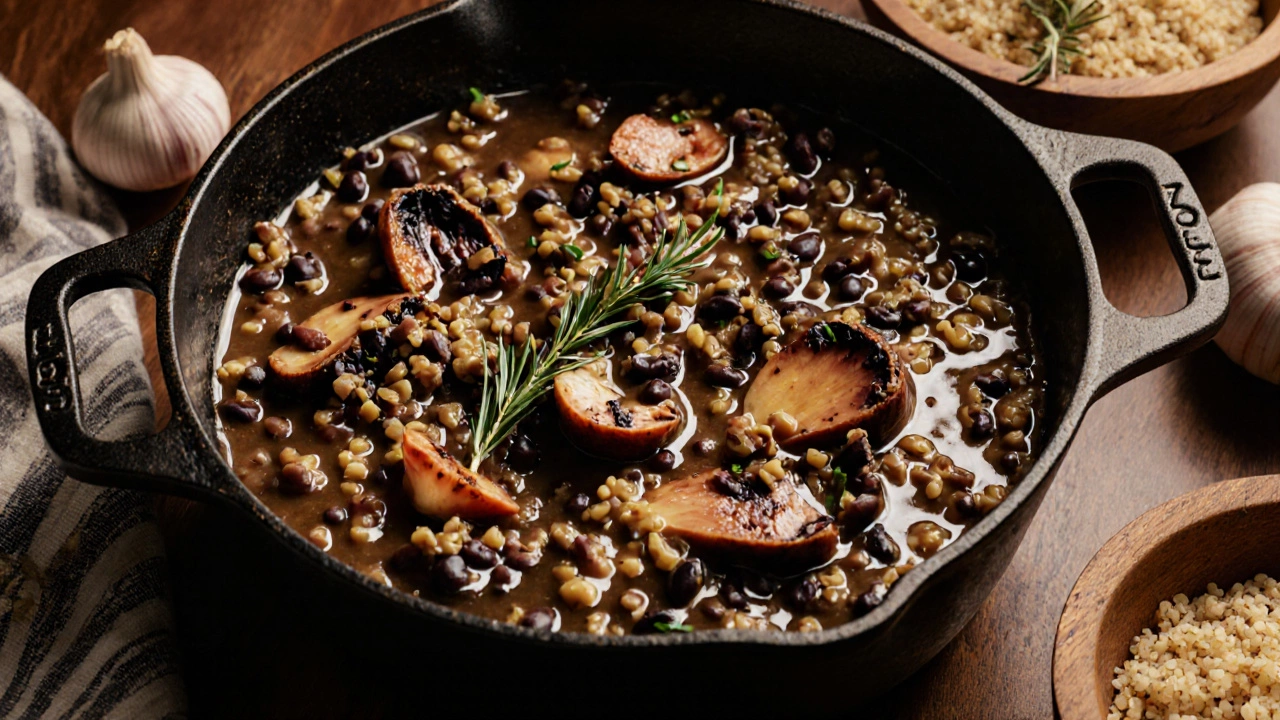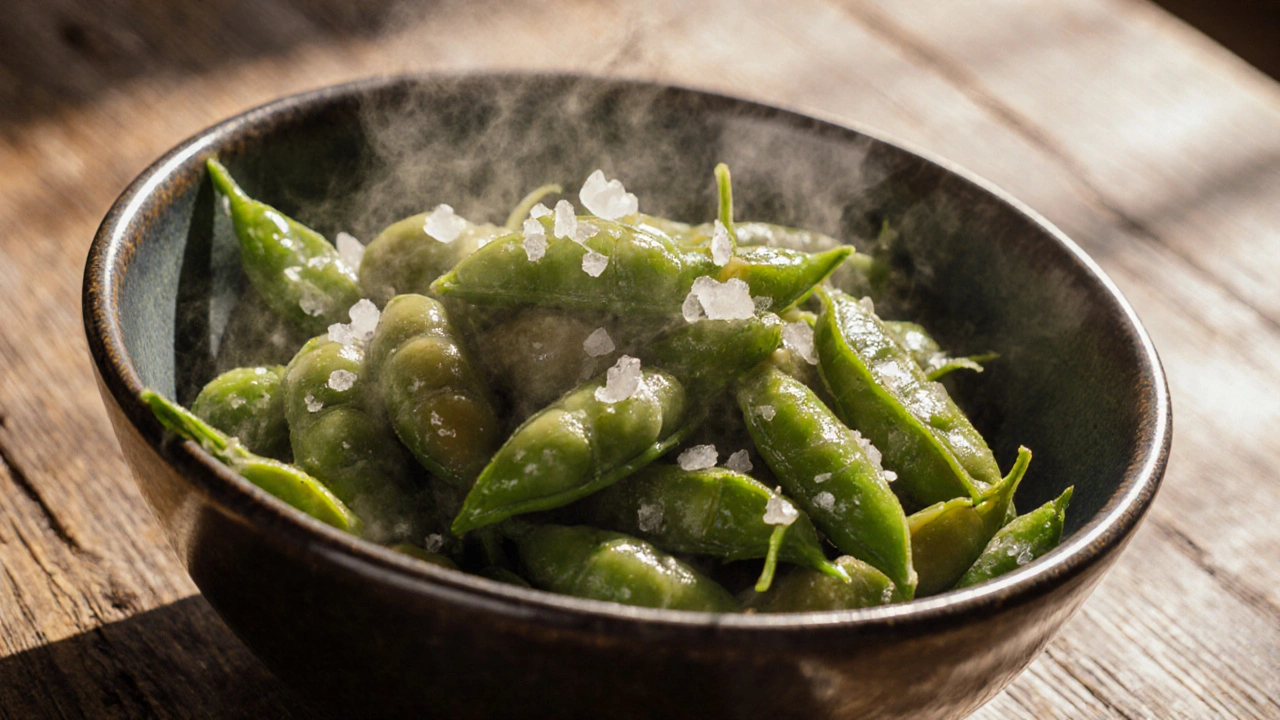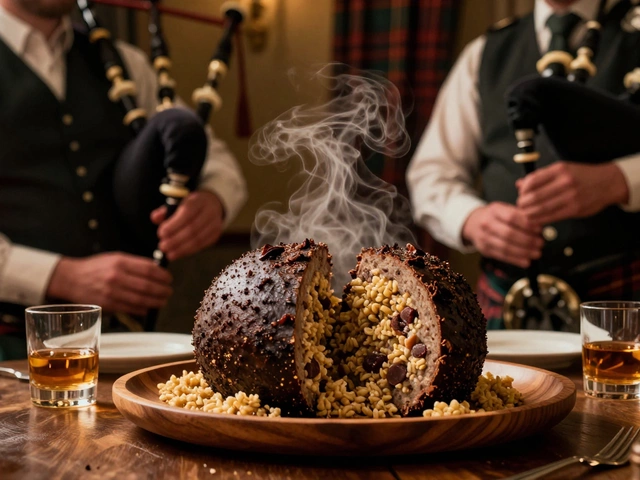High-Protein Vegetarian Meal Builder
Create balanced vegetarian meals that keep you full just like meat. Select your ingredients and see how much protein you're getting compared to meat.
Protein Summary
Tip: Combine with legumes and whole grains for complete protein. For reference, a 4-oz chicken breast has 26g protein.
For optimal satiety, aim for at least 15g protein per meal. Try pairing your protein sources with healthy fats (like avocado) and fiber-rich veggies.
1. Protein Power Bowl: 1 cup lentils + 1/2 cup edamame + 1 cup mushrooms + 1 tbsp tahini
2. Meaty Jackfruit: 1 cup jackfruit (with 1/2 cup black beans) + 1/2 cup quinoa + roasted sweet potatoes
3. Portobello Burger: 1 large portobello mushroom + 1/2 cup black beans + avocado + whole-grain bun
People ask, which vegetable is equal to meat? Not because they want to replace steak with a carrot, but because they’re tired of feeling hungry after a vegetarian meal. You eat your tofu stir-fry or lentil soup, and two hours later, you’re raiding the pantry again. That’s not because plant-based eating doesn’t work-it’s because most people pick the wrong veggies.
Meat isn’t just about protein-it’s about staying full
Meat works because it’s dense. It’s packed with protein, fat, and amino acids that signal your brain: you’re fed. Most vegetables? Water and fiber. You get volume, but not staying power. So the real question isn’t which vegetable tastes like meat-it’s which one gives you the same satisfaction.
Here’s the truth: no single vegetable matches meat in every way. But five vegetables come shockingly close when prepared right. They have the protein, texture, and nutrient density to keep you full for hours-no chicken breast required.
1. Soybeans (and edamame)
Soybeans aren’t just a protein source-they’re the closest thing to meat in a plant. One cup of cooked soybeans has 29 grams of protein. That’s more than a 4-ounce chicken breast (26g). And unlike tofu or tempeh, whole soybeans have fiber, iron, calcium, and all nine essential amino acids. That’s rare for plants.
Edamame is the easy version. Steam a cup, sprinkle with sea salt, and you’ve got a snack that keeps you full longer than a bag of chips. Add them to salads, grain bowls, or eat them straight from the pod. They’re crunchy, savory, and satisfying in a way most veggies just aren’t.
Studies from the American Journal of Clinical Nutrition show that soy protein triggers the same satiety hormones as animal protein. That’s why Japanese diets, rich in soy, have lower rates of overeating.
2. Lentils (especially black and green)
Lentils are the unsung heroes of plant-based eating. One cup of cooked lentils gives you 18 grams of protein and 15 grams of fiber. That combo is a fullness powerhouse. Fiber slows digestion. Protein triggers satiety hormones. Together, they make you feel like you just ate a steak.
Black lentils (also called Beluga lentils) hold their shape better than red ones. They have a chewy texture that mimics ground meat. Try them in tacos, bolognese, or even veggie burgers. They brown nicely when sautéed with garlic and smoked paprika. No one guesses they’re not beef.
And unlike meat, lentils don’t cost $8 a serving. A pound of dry lentils costs under $2 and makes six meals. That’s why they’re a staple in poor communities around the world-and why they’re the most practical meat substitute for budget-conscious eaters.
3. Seitan (wheat gluten)
Seitan isn’t a vegetable, but it’s made from wheat, which grows in the ground. So it counts. Made by washing away the starch from wheat flour, seitan is almost pure gluten. That’s why it has the chewy, fibrous texture of meat. One 3-ounce serving has 21 grams of protein.
It’s not a whole food like lentils or soybeans. But if you’re craving a burger that bites back, seitan is your best bet. You can buy it pre-made, or make it at home with vital wheat gluten, broth, and spices. Pan-fry it. Grill it. Shred it for sandwiches. It absorbs flavors like a sponge.
Warning: it’s not gluten-free. If you’re sensitive to wheat, skip it. But for everyone else, it’s the closest thing to meat texture you’ll find without buying a lab-grown steak.

4. Jackfruit (when prepared right)
Jackfruit gets a bad rap. People buy it thinking it’ll taste like pulled pork-and then they’re disappointed. That’s because they cook it wrong.
Raw jackfruit is bland. But when you shred young green jackfruit and slow-cook it in barbecue sauce with smoked salt and liquid smoke? It shreds like pulled pork and holds sauce like a champ. One cup has 3 grams of protein-not impressive on its own.
But here’s the trick: pair it with black beans or lentils. That combo pushes the protein to 15+ grams per serving. Add a side of roasted sweet potatoes or quinoa, and you’ve got a meal that fills you up like ribs. It’s not the jackfruit alone-it’s the combination.
It’s not the protein king. But it’s the texture king. And when you layer it with other high-protein foods? It works.
5. Mushrooms (especially portobello and oyster)
Portobello mushrooms are the original meat substitute. Grill one big cap, brush it with balsamic glaze, and pile on avocado and caramelized onions. You’ve got a burger that’s rich, savory, and heavy in the stomach.
Why? Mushrooms contain glutamate-the same compound that makes meat taste umami. They’re not high in protein (about 3g per cup), but they’re dense in flavor and texture. When you roast them slowly, they lose water and concentrate their taste. That’s when they start to feel like meat.
Combine portobellos with a side of chickpeas or a quinoa salad, and you’ve got a complete protein meal. Oyster mushrooms, when fried until crispy, mimic bacon. They’re used in vegan bacon recipes for a reason.
Why most vegetarian meals fail
Most people eat a salad with chickpeas and call it a meal. But salads are mostly water. Chickpeas have protein, but if you’re not eating enough of them, or if they’re drowned in dressing, you’ll still be hungry.
Meat works because it’s calorie-dense and nutrient-rich. Vegetables alone? Not so much. The trick isn’t finding one magic veggie. It’s building meals with layers: protein + fiber + healthy fat + flavor.
Try this formula: 1 cup legume (lentils, soybeans, black beans) + 1 cup whole grain (brown rice, quinoa) + 1 cup cooked vegetable (mushrooms, roasted eggplant) + 1 tbsp fat (olive oil, tahini, avocado). That’s a plate that keeps you full for 5+ hours.

What doesn’t work
Spinach? Great for iron. Not for fullness. Broccoli? Fiber city. Protein? Barely 3g per cup. Zucchini noodles? Just water with a shape. You can’t trick your body into feeling full with volume alone.
And don’t rely on processed meat substitutes like veggie burgers unless they’re made with whole ingredients. Many are loaded with starch, oil, and sodium. Check the label: if the first three ingredients are water, soy protein isolate, and modified starch-you’re not getting real food.
Real-world example: A day of meat-free meals that actually fill you up
- Breakfast: Scrambled tofu with sautéed spinach and a slice of whole-grain toast
- Lunch: Lentil and mushroom stew with a side of quinoa
- Snack: Edamame with sea salt
- Dinner: Grilled portobello mushroom with black bean chili and roasted sweet potatoes
No meat. No hunger. No cravings by 8 p.m.
Bottom line
No single vegetable equals meat. But soybeans, lentils, seitan, jackfruit (with help), and mushrooms-when used smartly-can replace meat in meals and keep you just as satisfied. It’s not about one food. It’s about building plates that are balanced, dense, and flavorful.
If you’re tired of feeling hungry after vegetarian meals, stop looking for a magic veggie. Start building meals with protein, fiber, and fat-layered together. That’s how you eat like you’re eating meat… without ever touching it.
Is there a vegetable that has more protein than meat?
No single vegetable has more protein per serving than a typical cut of meat, but soybeans come very close. One cup of cooked soybeans contains 29 grams of protein-more than a 4-ounce chicken breast (26g). Other legumes like lentils and black beans have 15-18 grams per cup, which is less than meat but still substantial when combined with grains or other protein sources.
Can I get enough protein on a vegetarian diet without meat?
Yes, absolutely. Most people overestimate how much protein they need. The average adult needs about 0.8 grams of protein per kilogram of body weight. That’s 55 grams for a 150-pound person. You can hit that easily with lentils, tofu, edamame, seitan, quinoa, and Greek yogurt (if you eat dairy). Combining beans with rice or whole grains gives you complete protein-no meat needed.
Why do I still feel hungry after eating vegetarian meals?
Most vegetarian meals lack density. Salads, steamed veggies, and plain tofu don’t provide enough calories or fat to signal fullness. Meat has fat and protein that trigger satiety hormones. To fix this, add healthy fats (avocado, olive oil, nuts), fiber-rich legumes, and whole grains to your meals. A bowl with lentils, quinoa, roasted mushrooms, and tahini dressing will keep you full longer than a plain veggie wrap.
Is seitan a healthy meat substitute?
Seitan is high in protein and low in fat, making it a good option for those who need a chewy, meat-like texture. But it’s made from pure wheat gluten, so it’s not a whole food. It’s also high in sodium if store-bought. Homemade seitan with minimal salt and broth is healthier. Avoid it if you have celiac disease or gluten sensitivity.
What’s the best vegetarian protein for weight loss?
Lentils and edamame are top choices. They’re high in protein and fiber, which help control appetite and reduce cravings. They’re also low in calories compared to meat. One cup of lentils has 230 calories and keeps you full for hours. That’s better than a 4-ounce chicken breast (165 calories) if you’re trying to eat less overall.








Write a comment